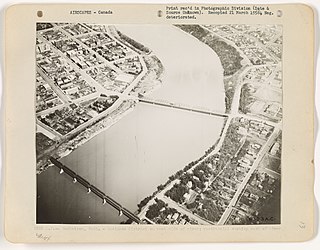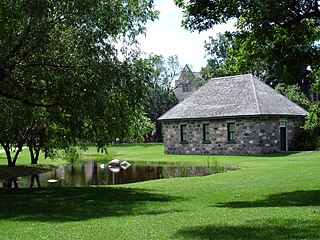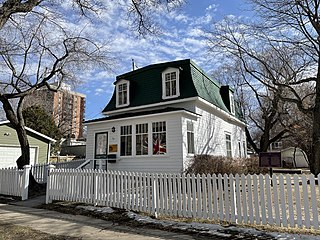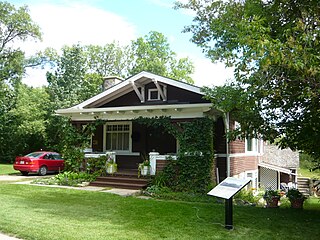
By the arrangements of the Canadian federation, the Canadian monarchy operates in Saskatchewan as the core of the province's Westminster-style parliamentary democracy. As such, the Crown within Saskatchewan's jurisdiction is referred to as the Crown in right of Saskatchewan, His Majesty in right of Saskatchewan, or His Majesty the King in right of Saskatchewan. The Constitution Act, 1867, however, leaves many royal duties in Saskatchewan specifically assigned to the sovereign's viceroy, the Lieutenant Governor of Saskatchewan, whose direct participation in governance is limited by the conventional stipulations of constitutional monarchy.

Nutana is a primarily residential neighbourhood located near the centre of Saskatoon, Saskatchewan, Canada. It includes the business district of Broadway Avenue. It comprises a nearly even mixture of low-density, single detached dwellings and apartment-style multiple unit dwellings. As of 2009, the area is home to 6,261 residents. The neighbourhood is considered a middle to upper-income area, with an average family income of $67,657, an average dwelling value of $206,830 and a home ownership rate of 51.3%. First established in 1883, Nutana was the original settlement of what now makes up the city of Saskatoon.

Varsity View is a mostly residential neighbourhood located near central Saskatoon, Saskatchewan, Canada. It is immediately south of the University of Saskatchewan campus. It is an older suburban subdivision, comprising a mixture of low-density, single detached dwellings, detached duplexes and apartment-style units. As of 2007, the area is home to 3,611 residents. The neighbourhood is considered a middle-income area, with an average family income of $50,587, an average dwelling value of $284,710 and a home ownership rate of 38.7%. Its proximity to the university gives this area its relatively high student population, almost 25% in 2005.

Riversdale is one of the oldest neighbourhoods in Saskatoon, Saskatchewan, Canada, located near the downtown area. It includes the business district of 20th Street. It consists mostly of low-density, single detached dwellings. As of 2021, the area was home to 2,534 residents.

Caswell Hill is a district in the city of Saskatoon, Saskatchewan, Canada. It derives its name from an early homesteader Robert Caswell one of the Temperance Colonists of 1883. It is an area of beautiful character homes first built ca. 1905, tiny war-time houses, and newer houses. Caswell is a thriving and diverse community nestled between two economic areas, the downtown core, and the stores lining 33rd Street West.

Grosvenor Park is a mostly residential neighbourhood located in east-central Saskatoon, Saskatchewan, Canada. It is a suburban subdivision, composed of a near-even mix of low-density, single detached dwellings and apartment-style units. As of 2006, the area is home to 1,645 residents. The neighbourhood is considered an upper-income area, with an average family income of $67,544, an average dwelling value of $329,988 and a home ownership rate of 44.8%.

City Park is a mixed-use neighbourhood located near the center of Saskatoon, Saskatchewan, Canada. It comprises a mix of single-family detached homes, apartment buildings and other semi-detached dwellings. It also contains a number of commercial zones with businesses. As of 2009, the area was home to 4,405 residents. The neighbourhood is considered a middle-income area, with an average family income of $42,236, an average dwelling value of $245,254 and a home ownership rate of 28.6%.

The history of Saskatoon began with the first permanent non-indigenous settlement of Saskatoon, Saskatchewan, Canada, in 1883 when Toronto Methodists, wanting to escape the liquor trade in that city, decided to set up a "dry" community in the rapidly growing prairie region. As of 1882 this area was a part of the provisional district named Saskatchewan, North-West Territories (NWT). Their organization, the Temperance Colonization Society, first examined this area in 1882 and found that it would make an excellent location to found their community based on the ideals of the temperance movement; Saskatoon traditionally considers 1882 its founding year and thus marked its centennial in 1982. The settlers, led by John Neilson Lake, arrived on the site of what is now Saskatoon by traveling by railway from Ontario to Moose Jaw, Assiniboia, NWT, and then completing the final leg via horse-drawn cart. The plan for the Temperance Colony soon failed as the group was unable to obtain a large block of land within the community. Nonetheless, John Lake is commonly identified as the founder of Saskatoon; a public school, a park and two streets are named after him.
Lyell Gustin was a pianist, teacher and adjudicator active in Saskatoon, Saskatchewan, from 1920 to the mid-1980s.

Woodlawn Cemetery is a cemetery located in Saskatoon, Saskatchewan, Canada. Located in the cemetery is the Next of Kin Memorial Avenue, a National Historic Site of Canada, that is dedicated to all those who served with Canada's armed forces.
There are numerous heritages and cultural attractions in the Canadian province of Saskatchewan. Museums, dinosaur digs, aboriginal cultural and heritage sites, art galleries, professional sport venues, spas, handcraft, antique and tea shops, agricultural tours, theatre, and archaeological sites comprise over 600 varied Saskatchewan institutions.

Victoria School is the name given to three public schools in Saskatoon, Saskatchewan, Canada, one of which was the first permanent school constructed in the city.

The Marr Residence is a National Historic Site located in the Nutana neighbourhood of Saskatoon, Saskatchewan, and was part of the original temperance colony that predated the city. Built in 1884 for stonemason Alexander "Sandy" Marr, it is the oldest building in Saskatoon on its original site. It was one of several houses requisitioned as a field hospital to treat wounded soldiers during the North-West Rebellion in 1885. When the hospital was closed in 1885 the home was returned to the Marr family. Although they left Saskatoon in 1889, the Marr family name remained associated with the house. The house remained a residential property until the 1970s.

The Land Titles Building is located at 311 21st Street East in the Central Business District of Saskatoon, Saskatchewan. The architectural firm of Storey and Van Egmond designed the building in the Romanesque Revival style. The building was constructed by Smith Brothers and Wilson in 1909. Additional expansions were done between 1910 and 1912. The building housed the land title office until 1959 when the office was transferred to the Law Courts Building. The provincial government stopped using the building when it was sold in 1994. The building now houses the law offices of Brayford and Shapiro.
Boyd McDonald is a Canadian pianist, fortepianist, composer, and music educator. An associate of the Canadian Music Centre, his compositional output includes works for choirs, bands, orchestras, and art songs. His works have been performed throughout Canada and Europe by ensembles like the Kitchener-Waterloo Symphony, the Renaissance Singers, the Scholars of London, Symphony Hamilton, the Waterloo Chamber Players, and the Wellington Winds among others.
Storey and Van Egmond was an architectural partnership in Regina, Saskatchewan, Canada, that functioned from 1907 to 1924. Initially, the principals were Edgar M. Storey (1863-1913) and William Gysbert Van Egmond (1883-1949).
David Webster (1885–1952) was a Scottish-Canadian architect best known for his designs of elementary schools in Saskatoon, Saskatchewan, Canada. His school designs were often in a Collegiate Gothic style emphasizing a central tower, locally referred to as a "castle style". Along with other local architects of his era, such as Walter LaChance and Storey and Van Egmond, Webster prospered during the province’s 1912 economic boom which sparked a frenzy of new construction.

The Bowerman House is a designated Municipal Heritage Property located in the Holiday Park, neighborhood of Saskatoon, Saskatchewan, Canada. The home is of a crafts-man "Western Stick" style. The house was built as a hunting lodge by Allan Bowerman, graduate from Kingston Military College, first postmaster in Saskatoon on the west side of the river, and member of Saskatoon's first town council. Bowerman was also responsible for the development of the Canada Building. The home was designed by Walter William LaChance. Bowerman sold the home in 1917 after the end of a construction boom in the city.
The Saskatoon Sanatorium was a tuberculosis sanatorium established in 1925 by the Saskatchewan Anti-Tuberculosis League as the second Sanatorium in the province in Wellington Park south or the Holiday Park neighborhood of Saskatoon, Saskatchewan, Canada. In 1929 Saskatchewan became the first jurisdiction to implement universal free diagnosis and treatment of tuberculosis, leading to better control of the disease by the three sanatoriums in the Province.
Marguerita "Rita" Spencer was a Canadian pianist, organist, composer and educator.















